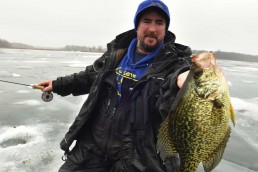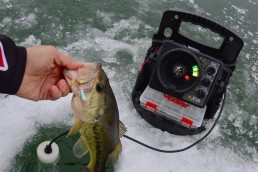Quick Hittin’ Tips to Propel Your Ice-fishing Success
SHARE THIS POST
Here are some quick ice fishing tips and musings to mull over:
Jigging spoon vs. teardrop spoon
Profiles, colors and actions attract a fish to a bait, and one of the most popular designs is the original Demon Spoon. These can catch virtually any fish swimming under the ice with its unique profile and fluttering motion on the fall. Sometimes, though that subtle flutter isn’t enough of a trigger to get fish, like white bass, walleyes or finicky crappies, to strike. That’s when a jigging spoon comes into play. These have more of a slab-like motion, giving it a more aggressive jig to allow the right action. Fish can act unresponsive, but an aggressive spoon will change their mood from nap to attack.
Droppers
These were designed mainly for deep-water perch, but they will work for all species, in all depths. The premise is that the fish are attracted to ones in a jig or spoon, but once they hone in on it, for whatever reason, they can lose interest. But products like the Pro Finesse Drop Chain will allow you to replace the treble hook of a jigging spoon with a smaller treble on a chain, tipped with bait so a fish will be attracted to the spoon, move down and hit the dropper every time. Droppers designed so that the hook does not come back and snag your line on the fall are ideal, and you can even make your own by tying your favorite ice jig under a jigging spoon. Heavier fluorocarbon at 8-pound-test works better because the line is stiffer than mono and spreads your jig away from a spoon on the fall.
Fully equipped tents
A tent is protection from the elements. Ones like the Frabill Aegis 2415 SideStep Ice Shelter can be fully loaded with rod holders, an espresso maker, fax machine or oven. But a shelter can also hold lights and shelves and provide tackle storage all the while giving you the comfort you need in a compact area. You can even hold six to eight rigged rods on a sled or a tent base by taking a boat battery storage box, cutting some plastic tubing to size and add some wood for support and stability to the bottom.
Are you enjoying this post?
You can be among the first to get the latest info on where to go, what to use and how to use it!
Hot-shots’ drop-shot
Drop-shotting is as great way to present baits through the ice. In current areas like Green Bay, anglers will put 1/2 to 2 ounces of weight to anchor one or two of the number 8 long shank hooks rigged with Finesse Plastic and a bunch of spikes or minnows. Some will tie them directly to a main line, which is the definition of drop-shotting, while others prefer a smaller, 4- to 6-inch length of fluorocarbon line to the hook, giving the presentation more of a floating action. You can also run a spoon on the bottom with dangling hooks up above instead of that weight on the bottom, or “drop-spooning” if you will. Also, tungsten jigs can be used here. Custom Jigs & Spins’ tournament pro angler Kevin Fassbind runs a heavier tungsten Chekai or Majmun on the bottom with a small-sized 12 to 16 as a dropper with a Wedgee rigged to the hook. This combo has given him a lot of success on the tournament trail, especially when the fishing is tough.
Rods, spring bobbers and the Quick Tip
Our favorite rod for this season is the Frabill Ice Rod. We also use the 26-inch Ice Hunter Quick Tip as well as it’s a great multi-use rod. We have caught everything, from 3-ounce bluegills to 30-pound flatheads. Rods like this can be used “as is” when tight-lining heavier jigs and spoons up to 1/8 ounce. For finesse bluegill and crappie fishing we have the same rod rigged with Frabill’s spring bobber. The spring detects bites well, but the only problem is that it can freeze up in the cold so it’s more suited for in-tent use. We also use titanium spring bobbers because they’re adjustable and can be set to any tension or jig weight used.
So give these ideas a try on the ice. You might just have a little more fun and catch more.
MWO
SHARE THIS POST
Did you enjoy this post?
You can be among the first to get the latest info on where to go, what to use and how to use it!
Walt Matan
Walt Matan has been a writer and television host for MidWest Outdoors for 30 years. An avid ice and open-water fisherman, he currently lives in the Quad Cities on the shores of the Mississippi River. He is the product developer and brand manager for Custom Jigs & Spins, B-Fish-N Tackle, and Rippin Lips Catfish Tackle. For more information visit customjigs.com.



